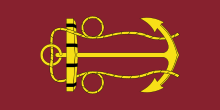History
For the periods the Board of Admiralty was not in commission, a special council of advisers known as the Lord High Admirals Council was established on the advice of the government of the day to which the Lord High Admiral had to accept the advisers recommended by the government. [4]
In 1702, Prince George was authorised to appoint a Lord Admirals Council – there were originally three naval members and one civil member who were usually a member of parliament. Between 1703 and the spring of 1704, the permitted number of members of the council was raised to six. After spring 1704 until 1708, the upper limit of members of the council was increased to seven. In May 1827, the Duke of Clarence was authorised to appoint a council that consisted of no more than four members to hold office during his tenure; by July 1827, the right of the Lord High Admiral to appoint council members was passed over to the Monarch. The Duke of Clarence's councils usually consisted of two naval members and two civil members, in all twelve councils would convene during the two periods.

Admiral of the Fleet Sir George Rooke was an English naval officer. As a junior officer he saw action at the Battle of Solebay and again at the Battle of Schooneveld during the Third Anglo-Dutch War. As a captain, he conveyed Prince William of Orange to England and took part in the Battle of Bantry Bay during the Williamite War in Ireland.

Admiral of the Fleet Sir Cloudesley Shovell was an English naval officer. As a junior officer he saw action at the Battle of Solebay and then at the Battle of Texel during the Third Anglo-Dutch War. As a captain he fought at the Battle of Bantry Bay during the Williamite War in Ireland.

Admiral of the Fleet Edward Russell, 1st Earl of Orford, PC was a Royal Navy officer and politician. After serving as a junior officer at the Battle of Solebay during the Third Anglo-Dutch War, he served as a captain in the Mediterranean Sea in operations against the Barbary pirates.

Josiah Burchett, of Hampstead, Middlesex, was a British naval administrator and Whig politician, who sat in the English and British House of Commons between 1705 and 1741. He was Secretary of the Admiralty in England, a position he held for almost fifty years from 26 September 1694 to 14 October 1742. In addition to his administrative duties, he was the author of the first general history of the Royal Navy, published in 1720 and based on official Admiralty records.
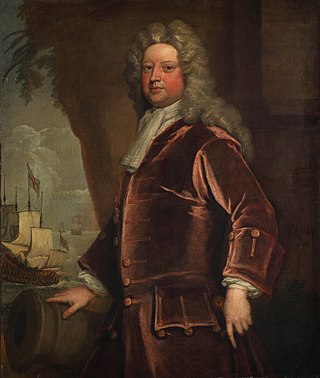
Admiral of the Fleet Sir John Norris was a Royal Navy officer and Whig politician. After serving as a junior officer during the Nine Years' War and the Williamite War in Ireland, he was given command of a squadron sent to North America to protect British settlements on the banks of Hudson Bay in 1697. Although he developed a plan to recapture some territories in Newfoundland and Labrador taken by French forces the previous winter, he was prevented from implementing that plan when the local council overruled him.

Admiral of the Fleet George Byng, 1st Viscount Torrington,, of Southill Park in Bedfordshire, was a Royal Navy officer and statesman. While still a lieutenant, he delivered a letter from various captains to Prince William of Orange, who had just landed at Torbay, assuring the Prince of the captains' support; the Prince gave Byng a response which ultimately led to the Royal Navy switching allegiance to the Prince and the Glorious Revolution of November 1688.

Vice-Admiral James Berkeley, 3rd Earl of Berkeley, was the son of Charles Berkeley, 2nd Earl of Berkeley and the Hon. Elizabeth Noel. He was known by the courtesy title of Viscount Dursley prior to succeeding as Earl of Berkeley in 1710. He was a distinguished Royal Navy officer who served as First Lord of the Admiralty during the reign of King George I.

Admiral of the Fleet Matthew Aylmer, 1st Baron Aylmer, of Covent Garden, Westminster, and Westcliffe, near Dover, was an Anglo-Irish Royal Navy officer and Whig politician who sat in the English and British House of Commons between 1695 and 1720.

The Parliamentary and Financial Secretary to the Admiralty also known as the Parliamentary and Financial Secretary to the Board of Admiralty was a position on the Board of Admiralty and a civil officer of the British Royal Navy. It was usually filled by a Member of Parliament. Although he attended Board of Admiralty meetings informally he was not made a full member of that Board until 1929. He served as the deputy to the First Lord of the Admiralty in Parliament and was mainly responsible for all naval finance and spending proposals from 1625 until 1959.
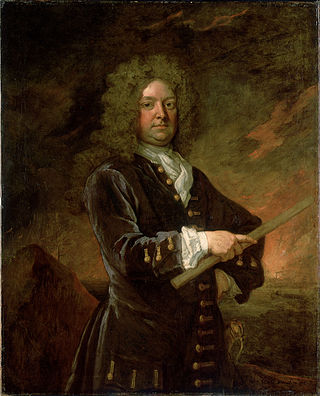
Admiral of the Fleet Sir John Leake was a Royal Navy officer and politician. As a junior officer he saw action at the Battle of Texel during the Third Anglo-Dutch War. He then distinguished himself when he led the convoy that broke the barricading boom at Culmore Fort thereby lifting the siege of Derry during the Williamite War in Ireland. As a captain he saw action in some of the heaviest fighting at the Battle of Barfleur and was also involved in a successful attack on the French ships at the Battle of La Hogue during the Nine Years' War.

HMS Eagle was a 70-gun third rate ship of the line of the Royal Navy, builtat Portsmouth Dockyard during 1677/79. When completed she was placed in Ordinary for 10 years. She was in active commission during the War of the English Succession partaking in the Battle of Barfleur. She was rebuilt in 1699 at Chatham. She again played an active role in the early part of the War of Spanish Succession participating in the Capture of Gibraltar, and the Battle of Velez Malaga. She was wrecked in the Isles of Scilly in October 1707.

HMS Orford was a 70-gun third-rate ship of the line of the Royal Navy, launched at Deptford in 1698. She carried twenty-two 24-pounder guns and four (18-pounder) culverins on the lower deck; twenty-six 12-pounder guns on the upper deck; fourteen (5-pounder) sakers on the quarter-deck and forecastle; and four 3-pounder guns on the poop or roundhouse.

The First Lord of the Admiralty, or formally the Office of the First Lord of the Admiralty, was the political head of the English and later British Royal Navy. He was the government's senior adviser on all naval affairs, responsible for the direction and control of the Admiralty, and also of general administration of the Naval Service of the Kingdom of England, Great Britain in the 18th century, and then the United Kingdom, including the Royal Navy, the Royal Marines, and other services. It was one of the earliest known permanent government posts. Apart from being the political head of the Naval Service the post holder was simultaneously the pre-eminent member of the Board of Admiralty. The office of First Lord of the Admiralty existed from 1628 until it was abolished when the Admiralty, Air Ministry, Ministry of Defence and War Office were all merged to form the new Ministry of Defence in 1964. Its modern-day equivalent is the Secretary of State for Defence.

The Scilly naval disaster of 1707 was the loss of four warships of a Royal Navy fleet off the Isles of Scilly in severe weather on 22 October 1707. Between 1,400 and 2,000 sailors lost their lives aboard the wrecked vessels, making the incident one of the worst maritime disasters in British naval history. The disaster has been attributed to a combination of factors, including the navigators' inability to accurately calculate their positions, errors in the available charts and pilot books, and inadequate compasses.

Admiral of the Fleet Sir Stafford Fairborne was a Royal Navy officer and Whig politician. As a captain he saw action in command of various ships at the Battle of Beachy Head, at the Battle of Barfleur and at the Battle of Lagos during the Nine Years' War.
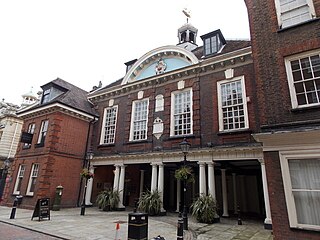
The Rochester Guildhall is an historic building located in the High Street in Rochester, Kent, England. It is a Grade I listed building.

Rear-Admiral John Leveson-Gower was a Royal Navy officer and politician from the Leveson-Gower family. As a junior officer he saw action at the Battle of Lagos in August 1759 during the Seven Years' War. As captain of HMS Valiant he was present at the Battle of Ushant on 17 July 1778 during the American War of Independence. He went on to be a junior Lord of the Admiralty and then First Naval Lord. He also sat as Member of Parliament for several constituencies.
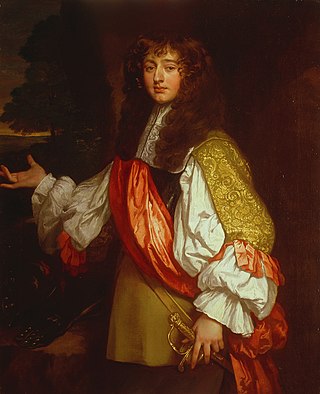
Rear Admiral Sir John Chicheley was a Royal Navy officer. He commanded a squadron at the Battle of Schooneveld in June 1673 and the Battle of Texel in August 1673 during the Franco-Dutch War. He went on to be Commissioner of the Ordnance and then Senior Naval Lord. He was also a Member of Parliament.
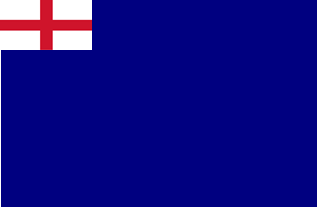
The Irish Squadron originally known as the Irish Fleet was a series of temporary naval formations assembled for specific military campaigns of the English Navy, the Navy Royal and later the Royal Navy from 1297 to 1731.
